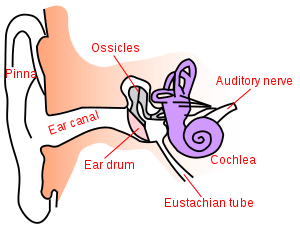Conductive hearing loss
| Conductive hearing loss | |
|---|---|
 |
|
| Anatomy of the human ear. | |
| Classification and external resources | |
| Specialty | otolaryngology |
| ICD-10 | H90.0-H90.2 |
| ICD-9-CM | 389.0 |
| DiseasesDB | 3043 |
| MeSH | D006314 |
Conductive hearing loss occurs when there is a problem conducting sound waves anywhere along the route through the outer ear, tympanic membrane (eardrum), or middle ear (ossicles). This type of hearing loss may occur in conjunction with sensorineural hearing loss (mixed hearing loss) or alone.
Conductive hearing loss occurs uniformly over all frequencies, resulting in sound and voices which seem faint or muffled.
For basic screening, hearing loss with a one-sided conductive component can be differentiated through the combined use of both the Weber and Rinne tests. If the hearing loss has a neural component on only one side, the Weber test, in which a tuning fork is touched to the midline of the forehead, can determine which ear is affected; the person will hear the sound softer in the affected ear. The Rinne test, which tests air conduction versus bone conduction is negative (abnormal result).
When a Weber test is carried out, sound localizes to the ear affected by the conductive loss. A Rinne test, in which air conduction is normally greater than bone conduction, is usually negative (abnormal – note unusual terminology here compared with other medical tests), and shows greater bone conduction than air conduction.
The following table compares sensorineural hearing loss to conductive:
Pure tone audiometry, a standardized hearing test over a set of frequencies from 250Hz to 8000Hz, may be administered by a medical doctor or audiologist or audiometrist, with the result plotted separately for each ear on an audiogram. The shape of the plot reveals the degree and nature of hearing loss, distinguishing conductive hearing loss from other kinds of hearing loss.
Common causes of conductive hearing loss include:
Fluid accumulation is the most common cause of conductive hearing loss in the middle ear, especially in children. Major causes are ear infections or conditions that block the eustachian tube, such as allergies or tumors. Blocking of the eustachian tube leads to decreased pressure in the middle ear relative to the external ear, and this causes decreased motion of both the ossicles and the tympanic membrane.
...
Wikipedia
